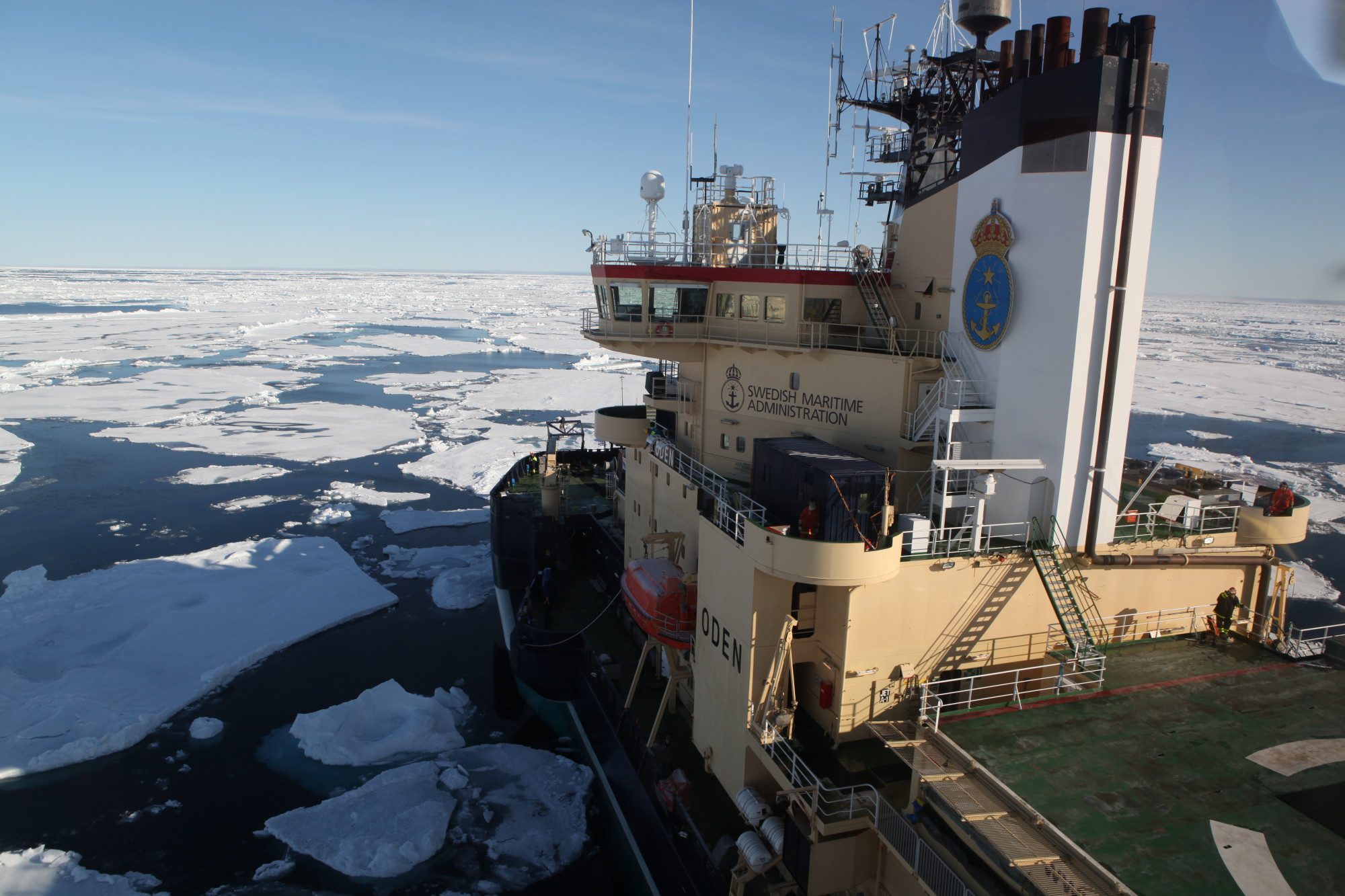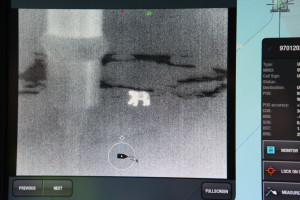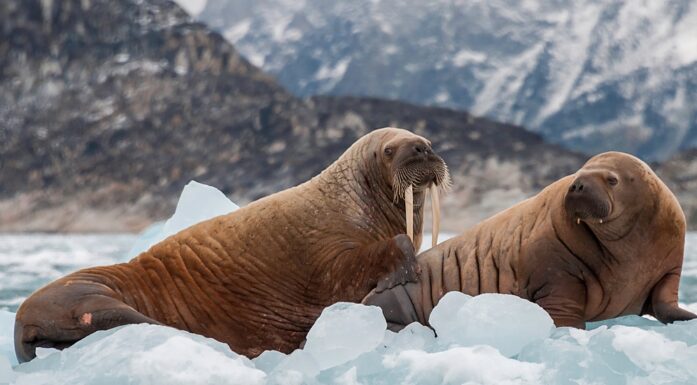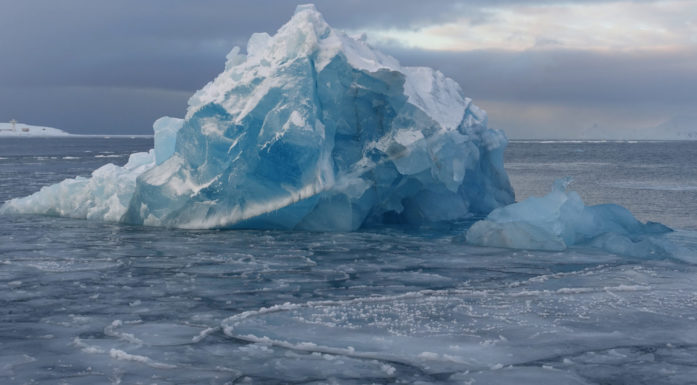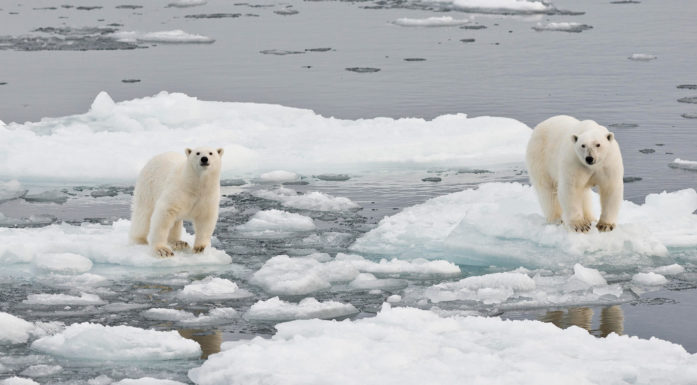Working safely to protect a cold, remote place
Researchers with NTNU’s Sustainable Arctic Marine and Coastal Technology centre don’t just study health, safety and environment (HSE) issues in their research in the High Arctic – they live HSE first hand. That first-hand experience makes industry safer, and protects the Arctic’s fragile environments.
The Arctic is a place where maps are not to be trusted.
Glaciers may surge one month, and grind to a halt the next. Crevasses can yawn open one week where it was safe to travel the week before. For half of the year, it is cold – very cold – and dark. And help can be far, far away.
“There are no ‘road signs’ in the Arctic and in Svalbard,” says Fred Skancke Hansen, director of HSE and Infrastructure for UNIS, the University Centre in Svalbard. Instead, he says, you have to rely on practical knowledge refined over years of experience working in this rapidly changing place.
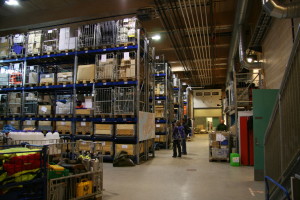
The University Centre in Svalbard, called UNIS, has a huge storeroom with every kind of safety equipment imaginable, from emergency gear to avalanche beepers. Nearly 1500 students and researchers go through UNIS HSE courses every year, including many SAMCoT and NTNU researchers and students. Photo: Nancy Bazilchuk/NTNU
Developing and refining the experience needed to protect the Arctic are key goals of NTNU’s Sustainable Arctic Marine and Coastal Technology centre (SAMCoT).
SAMCoT works hand-in-hand with Hansen and his colleagues at UNIS to offer safety training for SAMCoT students and staff, and in honing HSE practices that are used by researchers and the centre’s industry partners, including Statoil, DNV, Total, GDF Suez and Shell.
Increasing development in the Arctic demands new practices
SAMCoT is a centre for research-based innovation that has been funded by the Research Council of Norway from 2011 to 2019. Centres like SAMCoT are designed to work cooperatively with industry partners to “enhance the capability of the business sector to innovate by focusing on long-term research,” according to the Research Council.
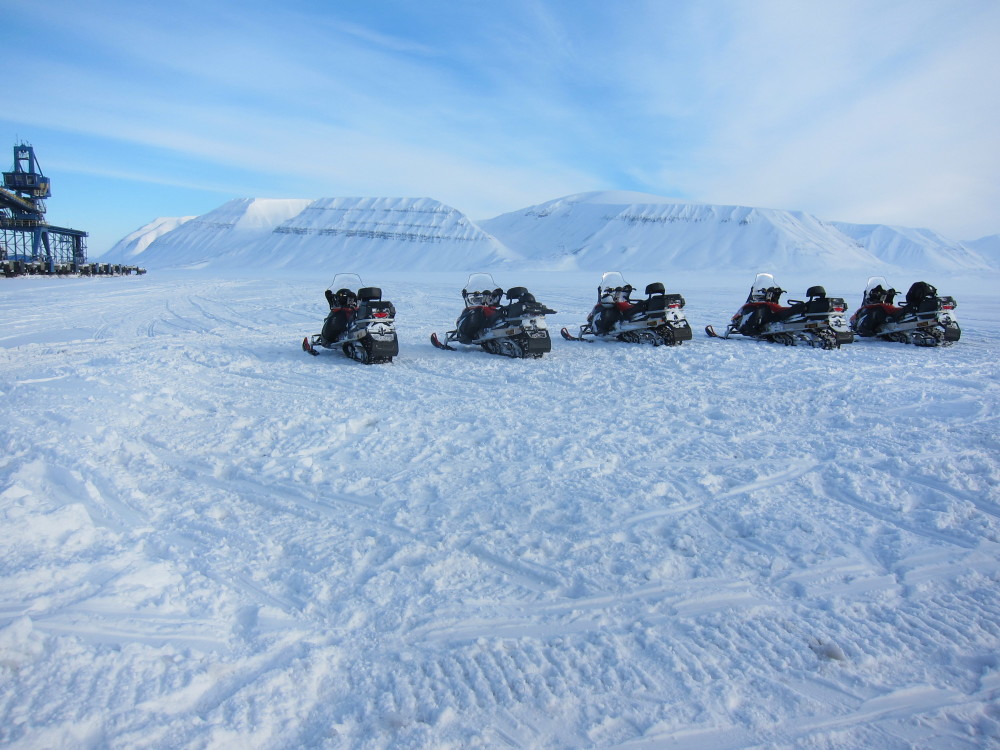
Snowmobiles parked all pointing towards home, out on the sea ice outside of Svea, Svalbard. One important safety rule when out in the Arctic is to always park your snowmobile faced in the direction of escape. Photo: Nancy Bazilchuk/NTNU
Arne Gürtner is Manager for Arctic Technology, Research, Development and Innovation for Statoil ASA and chairman of the SAMCoT board.
Gürtner says that energy companies like Statoil have a great deal of experience in operating production platforms and facilities in the cold. But they have less experience with working directly on the ice and with icebergs – both of which are important research areas for SAMCoT. This experience will also be critical in the years ahead, as exploration and development in the Arctic increases.
“The centre’s edge is really the knowledge it creates about operations on the ice – doing field work on the ice and with icebergs, and doing this all in remote locations,” he said. “This knowledge, when transferred back to theory, guidelines and best practices, will drive the industry knowledge base and create a lot of added value. The oil and gas industry have conducted research and field expeditions, but I think the centre has great experience that can help the industry raise its HSE standards.”
- You might also like: Celebrity ice
Learning how to protect ships, docks from ice loads
SAMCoT has six different “work packages,” or research areas, where professors and graduate students conduct research, publish their results in academic journals, and share their findings with industry partners.
Much of this research relies on fieldwork, where scientists collect information about physical phenomena in the Arctic that have been little studied – until now.
From June to September 2014, for example, a group of SAMCoT researchers measured tidal variations in sea level in the narrow straits to Dickson Fjord in Svalbard.

Flare guns are a must out on the ice. Here, two ice researchers examine an ice block on the sea ice outside of Svea, on Svalbard. Photo: Maria Azucena Gutierrez Gonzalez/NTNU SAMCoT
Others studied soil characteristics and tidal variations near a pipeline landfall in Longyearbyen, Svalbard’s largest town.
Still other researchers worked with making computer models of the hydrodynamic effects on ice upstream and downstream of floating structures – which naturally relies on field measurement of ice, to name just a few activities.
The knowledge generated by this research can help industries that operate in the Arctic to better protect the environment by making sure that ships, docks, piers and pipelines are all constructed to tolerate ice loads.
But simply conducting research in the Arctic requires a level of awareness of risks and safety procedures that also provides valuable information to the industry – although it may not result in academic publications per se.
“The SAMCoT industrial partners can learn from how we operate in the field, at sea, on ice and on land,” SAMCoT centre director Sveinung Løset says. “They can also learn from how we assess risks and risk levels, how we identify critical tasks, and how we handle risks in an extreme environment.”
Strict regulations can be dangerous
As a SAMCoT academic partner, UNIS works closely with the centre to develop best practice HSE standards that address practical problems, Hansen said.
Hansen said every field experience offers UNIS and its SAMCoT partners the chance to further refine HSE practices. Sometimes that may mean making regulations more flexible – which is often the opposite of the way large companies work.

Martin Indreiten, Coordinator of Logistics Services, University Centre in Svalbard, shows a satellite telephone that is sent out with different student and research groups as necessary. Behind him is a polar bear poster that is used for target practice — just in case. Photo: Nancy Bazilchuk/NTNU
“Often we see that strict safety regulations make things more dangerous because they set very strict limitations on what you can use and how you can use it,” he said. “Sometimes we need to look into the practical side of things and see what is most practical in this kind of scenario while still being safe.”
Less clumsy – and warmer
A good example is the use of what are called “passenger suits” versus flotation or survival suits while researchers are working out on the ice.
Traditionally, oil companies will require that all personnel wear warm, bulky survival suits in helicopters travelling to cold areas. It makes sense: if the helicopter goes down, then passengers will be protected if they end up in the icy waters of the Barents Sea or Arctic Ocean.
That same logic has been traditionally applied to industry personnel who might be working out on sea ice. Industry workers are generally required to wear survival suits out on the ice, so that they will be protected if they should fall though the ice.
But Hansen says that UNIS has found that survival suits can actually make work riskier out on the ice.
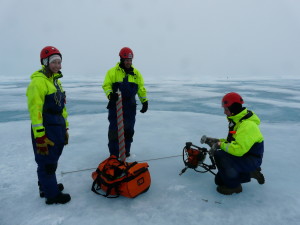
PhD candidates out on the sea ice during the 2013 Oden Arctic Technology Research Cruise. Their brightly coloured suits are also flexible enough so they can work and stay warm at the same time. Photo: SAMCoT/NTNU
Some survival suits can be extremely awkward, he said, and make it difficult for a researcher or worker to move. That means people who wear them can actually get colder than if they were wearing something that is much more flexible and lighter.
“It’s a big hazard if you get cold, because you get clumsy and you make mistakes,” Hansen said. “Other types of suits may not be that waterproof and will not keep you alive for many hours in the water, but they are still good enough if you have a ship right next to you that you can go on board if you fall into the water.”
“These suits make it easier to work, so your hands are warm, your feet are warm, and that adds up to a safer situation than if you were wearing a survival suit like you do when you are in a helicopter.”
- You might also like: Secrets of the High North
Protecting the environment an important part of HSE
The acronym for practices focused on health, safety and the environment – HSE –is most commonly associated with safety. But protecting the environment is also an important aspect of any HSE effort, says Statoil’s Gürtner.
“When we enter into new ‘frontier’ areas, we want to observe the environment around us and gain knowledge about the natural environment,” Gürtner said.
In the summers of 2012 and 2013, SAMCoT researchers, many of them PhD students, spent two weeks in the icy waters off the northeast coast of Greenland aboard the Oden. The Oden is a research vessel operated by the Swedish Polar Research Secretariat that is also an icebreaker. The waters off the northeast coast of Greenland – also called the Fram Strait – are among the least studied area in the world.
One big issue facing any development in northern waters is the effect that development will have on marine mammals in the environment, like whales and polar bears. But in order to understand where the vulnerable areas are, you need to know where the animals are.
A rich area for whales
The two visits that researchers made to the Fram Strait included marine mammal observers who were able to gather valuable information about the numbers and kinds of creatures that call these remote waters home.
For example, when the Oden crossed onto the edge of the continental shelf on its return to Svalbard in 2013, the marine mammal observers reported dozens of whale sightings, including sperm whales, white-beaked dolphins, humpbacked whales, fin whales and minke whales.

Marine mammal observers were able to listen under the ice during the 2013 Oden cruise to get a better idea of the natural underwater soundscape – which is crucial for understanding how future development might affect animals like whales, which use sound to communicate. Photo: Jan Durinck
“It was one of the best whale areas I have ever been to,” said Jan Durinck, from Marine Observers in Denmark, who was one of 5 observers on the 2013 cruise and who has more than 20 years of experience as a marine mammal observer.
“We know this is an area where we find animals, but their distribution can be quite patchy,” said Statoil marine biologist Jürgen Weissenberger at the time. “We just got lucky.”
In the end, the biologists reported approximately 150 sightings of marine mammals during the course of the 2013 cruise.
Seeing polar bears with infrared sensing
While direct observations are important, what may be even more important in protecting the environment is being able to predict the habitat characteristics that make an area attractive to marine mammals.
For that, SAMCoT researchers and partners from the University of Alaska and the University of Delaware in the United States have been working on an innovative 3D camera system to characterize the icescape around a ship while the vessel is underway. They also made underwater recordings as a way to document the underwater “soundscape”
By combining these data with the marine mammal observations, the group hopes to learn to recognize the characteristics of the ice cover that make it suitable as habitat for walrus and seals. They also used infrared sensors to detect marine mammals like polar bears, which might be hidden by icebergs or darkness.
Gürtner says the value of these observations and tools are two-fold – because they both add to the basic knowledge about mammals in the area, and it introduces new technologies for better understanding the environment.
“This gives us important new background information, and we can spin the technologies off to the universities for further research,” he said.
- You might also like: The Dirtiest Clean Place on Earth
“People focus on the wrong hazards”
Possibly the most important knowledge produced by SAMCoT is embodied in its PhDs. The centre works hard to make certain that all PhD candidates get field experience, if it is relevant to their research. That fieldwork is grounded in good safety procedures.
UNIS offers intensive training to SAMCoT students along with UNIS students, where participants do everything from learn to shoot guns – for polar bear protection – to drive a snowmobile safely.
Participants also learn about avalanche and sea ice safety, snow physics and glaciers, Hansen said. All told, about 1500 people go through safety training at UNIS per year, in more than 120 field safety courses.
The trick is that “humans in the Arctic may not be able to recognize threats,” Hansen said. People may be afraid of polar bears, but they are the smallest threat. “The weather is much more dangerous,” Hansen said. “People tend to focus on the wrong hazards.”
Planting the HSE ‘seed’ in PhD candidates
SAMCoT centre director Løset agrees that teaching the next generation of researchers is a valuable role for the centre.
“It’s important to transfer knowledge from experienced ‘Arctic researchers’ to younger generations,” he says. “And SAMCoT delivers these MScs and PhDs to the industry” with all of their HSE education and experience.
Statoil’s Gürtner says the industry is enthusiastic about the HSE training that SAMCoT PhDs receive, because it means both people and the environment are protected, and operations in the Arctic are thus safer.
“It’s important that we introduce young researchers to HSE,” Statoil’s Gürtner says. “We can create common ground and understanding. And once the students are exposed to this, it is great background for when they start working in the industry.”
